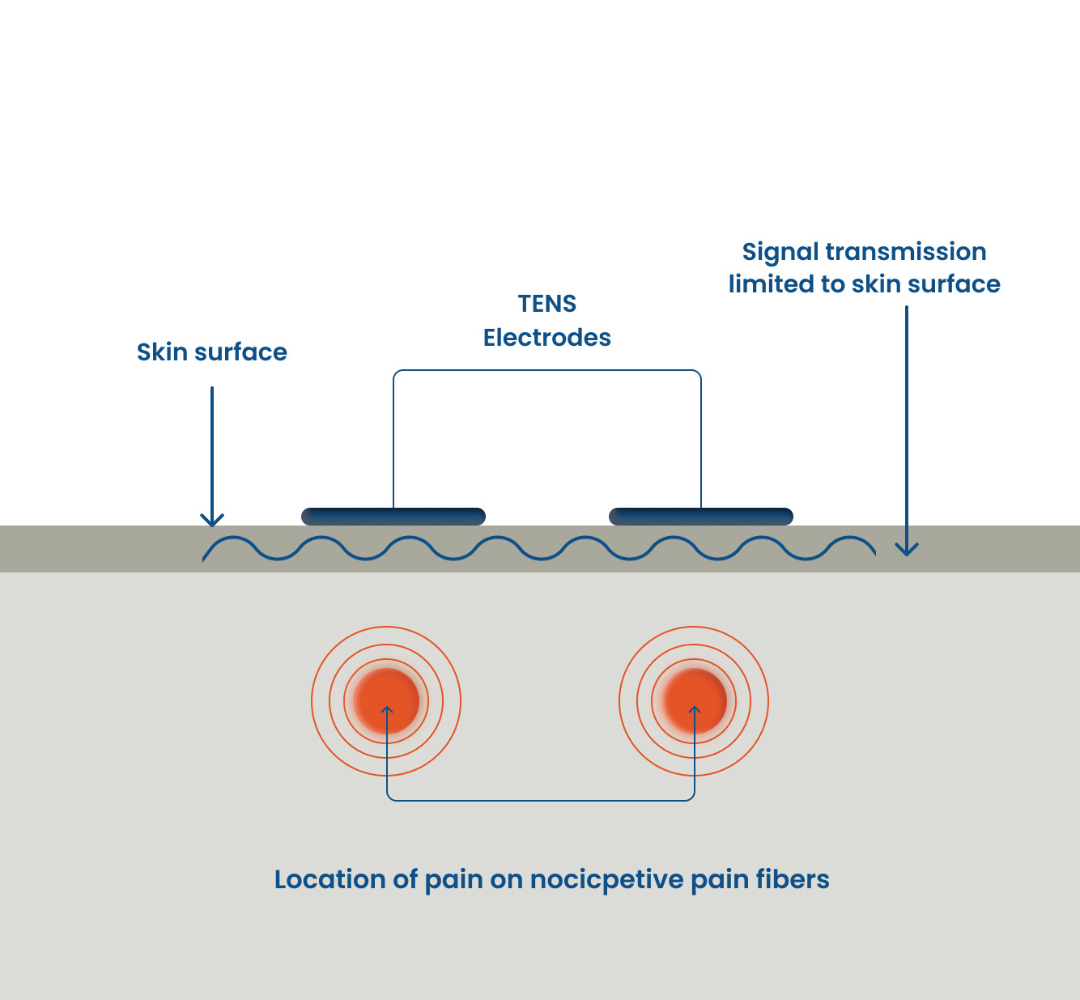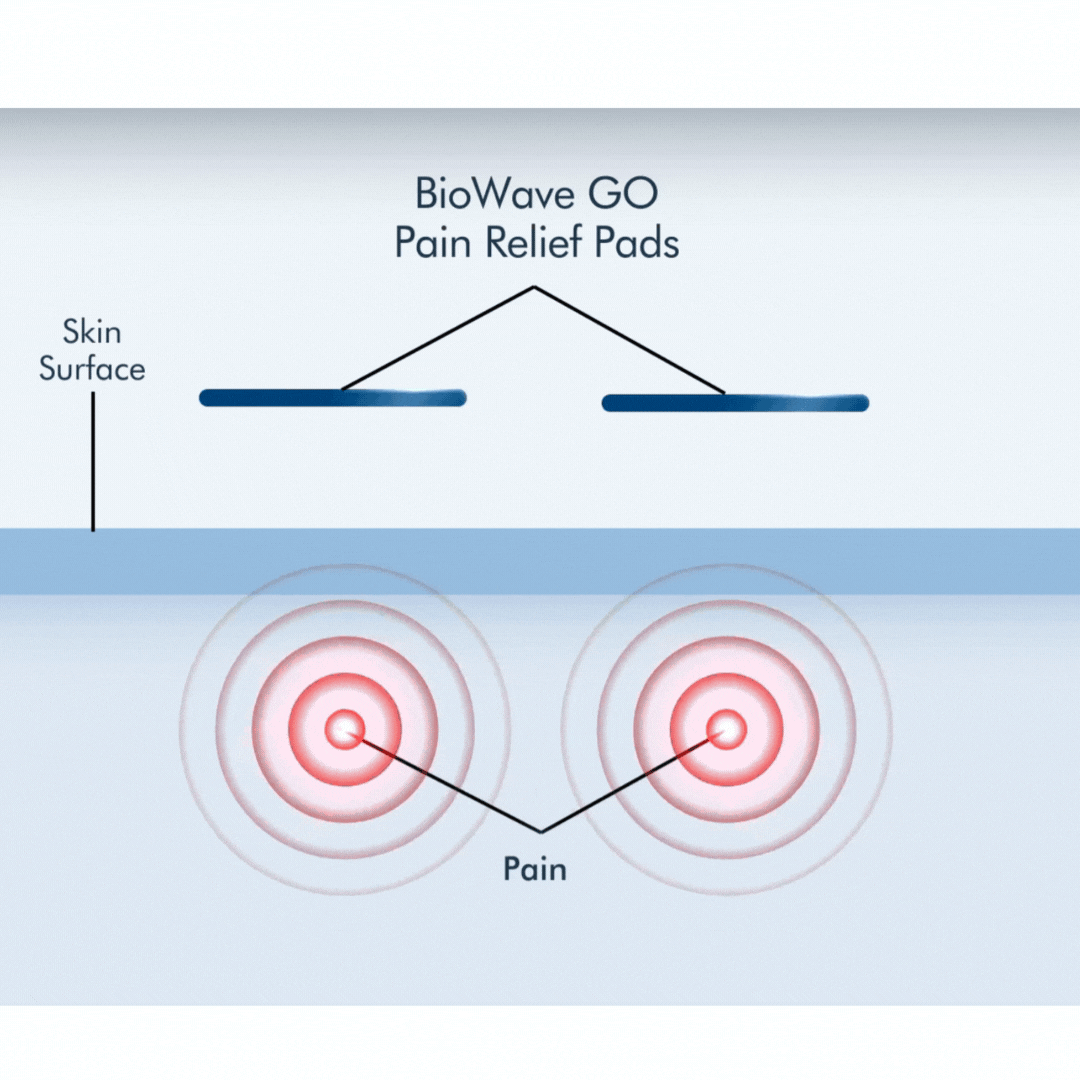Technology Designed To Block Pain At the Source
BioWave’s patented, proven, effective neurostimulation is changing lives every day. It leapfrogs today’s current technology with its advanced, patented pain blocking approach to pain relief. Because it’s designed to deliver therapeutic electrical signals into deep tissue, healthcare providers and patients alike affectionately call BioWave devices the “Blue Box.” Read on to understand the BioWave difference...

The BioWave Difference
There are many differences between BioWave’s neurostimulators and TENS, IFC and NMES devices. BioWave “blue boxes” utilize a proprietary signal mixing technology that delivers two continuously summed, high-frequency alternating current signals through skin into deep tissue where the body creates a new set of signals, one of which is in the form of a low-frequency electrical field. Percutaneous electrodes can provide even longer lasting pain relief than noninvasive electrodes. In addition to providing long-lasting efficacy, these signals are significantly more comfortable leading to improved patient treatment compliance.

BioWave High-Frequency Signal Technology
BioWave is a frequency conduction pain block. BioWave’s signal technology is based on the discovery that when two sinusoidal high-frequency signals are summed (added) together in the device and then delivered into the body through a single electrode, the signals will pass into deep tissue and affect all polarized tissues including nociceptive pain fibers.
As the summed signals pass through the body, polarized structures like the membrane of the C-fiber, A-delta fiber and muscle tissue act in a non-linear fashion and force the further multiplication of these signals, resulting in a new spectrum of signals. Multiplication of the high-frequency signals results in the formation of an active therapeutic low frequency electrical field focused in approximately a 3.5-inch diameter hemisphere beneath and surrounding each electrode, not across the surface of the skin between the electrodes.
This active electrical field is thought to hyperpolarize C-fibers inhibiting action potential propagation along these pain fibers (Frequency Conduction Block Theory). The active electrical field also induces hypoesthesia 5 minutes into the treatment. Hypoesthesia remains at the treatment site for up to 20 minutes following a 30-minute treatment. Additionally, muscle tissue is held in tension during the treatment, so the treatment feels like a deep smooth pressure sensation.
Active Feedback Control
All BioWave devices utilize the company’s patented signal technology which includes active monitoring and control of the electrical signals to ensure the accurate and safe delivery of therapeutic energy into deep tissue. BioWave neurostimulators calculate current density at the surface of each electrode in real time and automatically prevent patients from receiving too much current which could lead to a burn.
How Do BioWave Neurostimulators Work?
All BioWave devices deliver the two, summed high-frequency signals to the first electrode; they mix in the volume of tissue beneath that electrode, then pass to the second electrode and return to the device, completing the circuit. Instantaneously, the summed signals are delivered to the second electrode; they mix in the tissue beneath that electrode, then pass to the first electrode and return to the device.
The device alternates the summed high-frequency signals so quickly between the two electrodes that the patient cannot distinguish that the signals left either location. The net effect is there are two active electrodes, each of which can treat a distinct volume of tissue simultaneously and there is no noxious twitching sensation.
TENS Vs BioWave

TENS
Transcutaneous Electrical Nerve Stimulation
Low frequency signals (1-180Hz in frequency) are required to inhibit transmission of pain signals along nerve fibers in the body. However, electrical signals in this frequency range cannot pass through the skin because of the skin’s impedance and capacitance. TENS devices deliver pulsed low-frequency signals across the surface of skin typically between two surface electrodes placed on either side of the painful area. The result is a surface effect based on Gate Control Theory and the patient feels a noxious twitching, electrical sensation between the electrodes. The sensation produced by TENS may act as a distraction from the pain while the device is on, however, there is little residual benefit or functional improvement once the therapy session is over.

BioWave
High-frequency signals (greater than 1000Hz in frequency) easily pass through the skin. Trouble is, these signals used individually do not elicit an electrical or mechanical response from either nerve fibers or muscle tissue to inhibit pain transmission. BioWave’s signal technology is based on the discovery that when two sinusoidal high-frequency signals are summed (added) together in the device and then delivered into the body through a single electrode, the signals will pass into deep tissue and affect all polarized tissues including nociceptive pain fibers. As the summed signals pass through the body, polarized structures like the membrane of the C-fiber, A-delta fiber and muscle tissue act in a non-linear fashion and force the further multiplication of these signals, resulting in a new spectrum of signals. Multiplication of the high-frequency signals results in the formation of an active therapeutic low frequency electrical field focused in approximately a 3.5-inch diameter hemisphere beneath and surrounding each electrode, not across the surface of the skin between the electrodes. This active electrical field is thought to hyperpolarize C-fibers inhibiting action potential propagation along these pain fibers (Frequency Conduction Block Theory). The active electrical field also induces hypoesthesia 5 minutes into the treatment. Hypoesthesia remains at the treatment site for up to 20 minutes following a 30-minute treatment. Additionally, muscle tissue is held in tension during the treatment, so the treatment feels like a deep smooth pressure sensation.
Interferential Current (IFC)
IFC devices use four surface electrodes (two pairs of electrodes) that are placed in an “X” pattern surrounding a painful area. IFC delivers two separate pulsed, high-frequency signals, one between each pair of electrodes. The two pulsed signals cross paths on the surface of the skin. At the point of intersection, an interference pattern develops resulting in a new low-frequency signal equal to the difference between the signals. This is called the beat frequency. Since the two signals intersect on the surface, the resulting beat frequency produces mostly a surface effect similar to TENS and based on Gate Control Theory.
The device alternates the summed high-frequency signals so quickly between the two electrodes that the patient cannot distinguish that the signals left either location. The net effect is there are two active electrodes, each of which can treat a distinct volume of tissue simultaneously and there is no noxious twitching sensation.
Neuromuscular Electrical Stimulation (NMES)
NMES devices use up to eight electrodes typically placed at proximal and distal ends of a muscle to cause repeated cyclic contractions to reduce atrophy. NMES devices are not indicated for pain relief.
The device alternates the summed high-frequency signals so quickly between the two electrodes that the patient cannot distinguish that the signals left either location. The net effect is there are two active electrodes, each of which can treat a distinct volume of tissue simultaneously and there is no noxious twitching sensation.
Electrode Technology
BioWave’s therapeutic signals can be focused to different parts of the body by pairing electrodes of different sizes and types with one another. The electrodes are independent of one another and there is no maximum distance between the two electrodes.
Why You'll Love BioWave
BioWave Reviews


Relieve, Recover & Reclaim Your Quality of Life
Simple Doctor Recommended Techniques to Quickly Alleviate Pain, Sleep Better & Reduce Your Stress
By downloading you agree to the BioWave Privacy Policy

